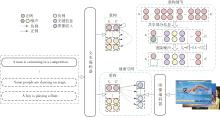| 1 |
GAO T, YAO X, CHEN D .SimCSE:simple contrastive learning of sentence embeddings[C]∥ Proceedings of the 2021 Conference on Empirical Methods in Natural Language Processing.Punta Cana:The Association for Computational Linguistics,2021:6894-6910.
|
| 2 |
ZHANG Z, CHEN K, WANG R,et al .Neural machine translation with universal visual representation[C]∥ Proceedings of the 8th International Conference on Learning Representations.[S. l.]:OpenReview.net,2020:1-14.
|
| 3 |
ZHAO Y, TITOV I .Visually grounded compound PCFGs [C]∥ Proceedings of the 2020 Conference on Empirical Methods in Natural Language Processing.[S. l.]:The Association for Computational Linguistics,2020:4369-4379.
|
| 4 |
LAZARIDOU A, PHAM N T, BARONI M .Combining language and vision with a multimodal skip-gram model [C]∥ Proceedings of the 2015 Conference of the North American Chapter of the Association for Computational Linguistics:Human Language Technologies.Denver:The Association for Computational Linguistics,2015:153-163.
|
| 5 |
ZABLOCKI E, PIWOWARSKI B, SOULIER L,et al. Learning multi-modal word representation grounded in visual context[C]∥ Proceedings of the Thirty-Second AAAI Conference on Artificial Intelligence.New Orleans:AAAI,2018:5626-5633.
|
| 6 |
KIELA D, CONNEAU A, JABBRI A,et al .Learning visually grounded sentence representations[C]∥ Proceedings of the 2018 Conference of the North American Chapter of the Association for Computational Linguistics:Human Language Technologies.New Orleans:The Association for Computational Linguistics,2018:408-418.
|
| 7 |
BORDES P, ZABLOCKI É, SOULIER L,et al .Incorporating visual semantics into sentence representations within a grounded space[C]∥ Proceedings of the 2019 Conference on Empirical Methods in Natural Language Processing and the 9th International Joint Conference on Natural Language Processing. Hong Kong:The Association for Computational Linguistics,2019:696-707.
|
| 8 |
TAN H, BANSAL M .Vokenization:improving language understanding with contextualized,visual-grounded supervision[C]∥ Proceedings of the 2020 Conference on Empirical Methods in Natural Language Processing.[S.l.]:The Association for Computational Linguistics,2020:2066-2080.
|
| 9 |
TANG Z, CHO J, TAN H,et al .Vidlankd:impro-ving language understanding via video-distilled knowledge transfer[J].Advances in Neural Information Processing Systems,2021,34:24468-24481.
|
| 10 |
ZHOU K, ZHANG B, ZHAO W X,et al .Debiased contrastive learning of unsupervised sentence representations[C]∥ Proceedings of the 60th Annual Meeting of the Association for Computational Linguistics.Dublin:The Association for Computational Linguistics,2022:6120-6130.
|
| 11 |
HOU P, LI X .Improving contrastive learning of sentence embeddings with focal infoNCE[C]∥ Procee-dings of the 2023 Conference on Empirical Methods in Natural Language Processing.Singapore:The Association for Computational Linguistics,2023:4757-4762.
|
| 12 |
WU X, GAO C, SU Y,et al .Smoothed contrastive learning for unsupervised sentence embedding[C]∥ Proceedings of the 29th International Conference on Computational Linguistics.Gyeongju:International Committee on Computational Linguistics,2022:4902-4906.
|
| 13 |
KLEIN T, NABI M .SCD:self-contrastive decorrelation of sentence embeddings[C]∥ Proceedings of the 60th Annual Meeting of the Association for Computational Linguistics.Dublin:The Association for Computational Linguistics,2022:394-400.
|
| 14 |
TIAN Y, SUN C, POOLE B,et al .What makes for good views for contrastive learning?[J].Advances in Neural Information Processing Systems,2020,33:6827-6839.
|
| 15 |
TSAI Y H H, WU Y, SALAKHUTDINOV R,et al .Self-supervised learning from a multi-view perspective [C]∥ Proceedings of the 9th International Conference on Learning Representations.[S.l.]:OpenReview.net,2021:1-18.
|
| 16 |
ZHANG M, MOSBACH M, ADELANI D,et al .MCSE:multimodal contrastive learning of sentence embeddings[C]∥ Proceedings of the 2022 Conference of the North American Chapter of the Association for Computational Linguistics:Human Language Technologies.Seattle:The Association for Computational Linguistics,2022:5959-5969.
|
| 17 |
ZHANG H, WU C, ZHANG Z,et al .ResNeSt:split-attention networks[C]∥ Proceedings of 2022 IEEE/CVF Conference on Computer Vision and Pattern Recognition Workshops.New Orleans:IEEE,2022:2735-2745.
|
| 18 |
CHEN S, ZHOU J, SUN Y,et al .An information minimization based contrastive learning model for unsupervised sentence embeddings learning[C]∥ Procee-dings of the 29th International Conference on Computational Linguistics.Gyeongju:International Committee on Computational Linguistics,2022:4821-4831.
|
| 19 |
YOUNG P, LAI A, HODOSH M,et al .From image descriptions to visual denotations: new similarity me-trics for semantic inference over event descriptions[J].Transactions of the Association for Computational Linguistics,2014,2:67-78.
|
| 20 |
LIN T Y, MAIRE M, BELONGIE S,et al .Microsoft COCO:common objects in context[C]∥ Proceedings of the 13th European Conference on Computer Vision.Zurich:Springer,2014:740-755.
|
 ), DONG Lifang1, HUANG Yeyang1, ZHOU Li2
), DONG Lifang1, HUANG Yeyang1, ZHOU Li2

